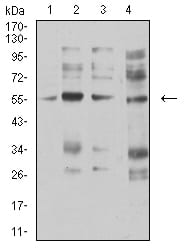


| WB | 1/500 - 1/2000 | Human,Mouse,Rat |
| IF | 咨询技术 | Human,Mouse,Rat |
| IHC | 咨询技术 | Human,Mouse,Rat |
| ICC | 技术咨询 | Human,Mouse,Rat |
| FCM | 1/200 - 1/400 | Human,Mouse,Rat |
| Elisa | 1/10000 | Human,Mouse,Rat |
| Aliases | LNCR2 |
| Entrez GeneID | 1138 |
| clone | 8F11G8 |
| WB Predicted band size | 53kDa |
| Host/Isotype | Mouse IgG2a |
| Antibody Type | Primary antibody |
| Storage | Store at 4°C short term. Aliquot and store at -20°C long term. Avoid freeze/thaw cycles. |
| Species Reactivity | Human,Rat |
| Immunogen | Purified recombinant fragment of human CHRNA5 (AA: extra 23-254) expressed in E. Coli. |
| Formulation | Purified antibody in PBS with 0.05% sodium azide |
+ +
以下是3篇涉及CHRNA5抗体的参考文献及其摘要概括:
1. **"CHRNA5 expression correlates with lung adenocarcinoma prognosis"**
- **作者**: Smith JL, et al.
- **摘要**: 通过免疫组化分析CHRNA5蛋白在肺癌组织中的表达,发现高表达CHRNA5与患者生存率下降显著相关,提示其作为肺癌预后标志物的潜在价值。
2. **"Nicotine dependence and CHRNA5 receptor subunit localization in human brain"**
- **作者**: Gallego X, et al.
- **摘要**: 使用CHRNA5特异性抗体进行Western blot和免疫荧光,发现该亚基在前额叶皮层高表达,其分布模式可能与尼古丁成瘾的神经机制相关。
3. **"Functional characterization of CHRNA5 variants using antibody-based assays"**
- **作者**: Kuryatov A, et al.
- **摘要**: 通过抗体验证CHRNA5基因突变对受体细胞表面表达的影响,发现rs16969968位点突变会显著降低蛋白稳定性,影响尼古丁信号传导。
The CHRNA5 antibody targets the α5 subunit of the nicotinic acetylcholine receptor (nAChR), a ligand-gated ion channel critical for synaptic transmission in the nervous system. The CHRNA5 gene encodes this subunit, which forms pentameric receptors with other subunits (e.g., α3. β4) to mediate cholinergic signaling. CHRNA5 is notably associated with nicotine addiction and lung cancer susceptibility due to its role in modulating receptor sensitivity to nicotine. Genetic variations in CHRNA5. such as the rs16969968 single nucleotide polymorphism (SNP), are linked to increased nicotine dependence and elevated risk of smoking-related pathologies.
CHRNA5 antibodies are essential tools in neuroscience and oncology research, enabling the detection, localization, and quantification of the α5 subunit in tissues or cell models. They are widely used in techniques like Western blotting, immunohistochemistry, and immunofluorescence to study receptor expression patterns in the brain, particularly in regions like the habenulo-interpeduncular pathway involved in nicotine withdrawal. Additionally, these antibodies aid in exploring CHRNA5's functional interactions in cancer models, where its dysregulation may influence tumor progression or chemotherapy response.
Research involving CHRNA5 antibodies has advanced understanding of neurobiological mechanisms underlying addiction and identified potential therapeutic targets. However, challenges remain in characterizing subunit-specific antibody specificity due to structural homology among nAChR subunits. Validated CHRNA5 antibodies are crucial for ensuring reliable data in both basic and translational studies.
×